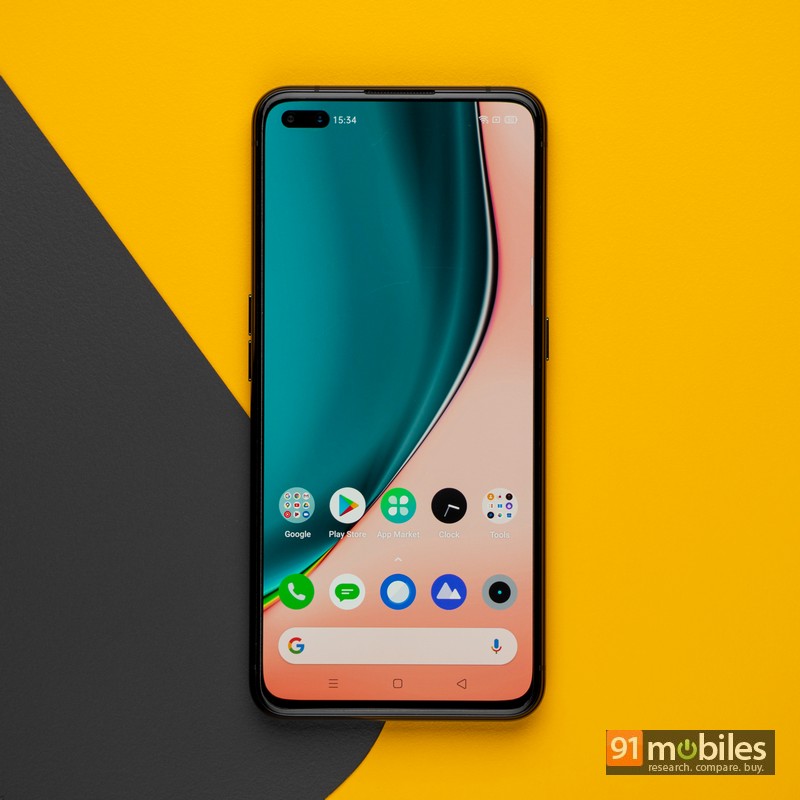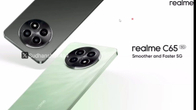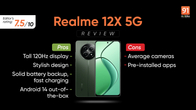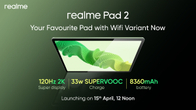It’s that time of the year when affordable flagships start cropping up in the Indian smartphone market, pioneered mostly by OnePlus and to some extent Xiaomi. Now Samsung, ASUS, new entrant iQOO, and Realme have also jumped onto this lucrative bandwagon. Suddenly there appears to be a ton of choices in the Rs 35,000 – Rs 45,000 price bracket as opposed to just two years back when one could blindly recommend a OnePlus device in this segment. Realme is signalling, after being in the Indian market for less than two years, that it is going to go toe-to-toe with the big guns with the launch of the Realme X50 Pro 5G.

The Realme X2 Pro (review) was the company’s first stab at the affordable flagship segment and it was, at that time, its most expensive phone. Now we have the Realme X50 Pro 5G, which has taken the mantle of the former OPPO sub-brand’s signature product. There are a number of things that instantly stand out for this device. It’s the first 5G phone to be announced in India (not that 5G networks will be available in the country soon), and the first with the Snapdragon 865 SoC. Apart from this it also has a 90Hz FHD+ display, dual selfie cameras, 65W SuperDart charging, UFS 3.1 storage and a 64MP quad-camera layout. The phone boasts top-tier specs in every department and its starting price stands at Rs 36,990. Is this the perfect deal? As I reviewed the phone, I was mightily impressed with what Realme has accomplished and the phone’s price point. Read on to find out more.

Verdict
The Realme X50 Pro 5G excels in almost all areas of mobile usage and for its price, there is no better or future-proof device. While some devices cut corners on aspects like design and display, the Realme X50 Pro is a wholesome device that is striving to provide the best of everything while keeping the price competitive. At long last, the flagship killer mantle will have a new phone placed that is not a OnePlus.
Design and display
It’s easy to confuse different Realme phones with each other when you look at them from the back. This is because, over the past six months or more, the company has been throwing the vertical quad-camera setup and a dual-tone colour shifting gradient on almost all its phones. The pattern differs between a few models, but unless you have a sharp eye, nearly all of Realme’s latest offerings look the same. I did like the matte finish that Realme has implemented this time around though, quite similar to the one seen on the OnePlus 7T (review). Moss Green is the variant that we received for review but it was the Rust Red version that caught my attention the most. However, there is something new on the front of the phone in the form of a dual punch-hole camera, a first for the company. A similar implementation, albeit on the right of the phone’s top, was used by the recently unveiled POCO X2 (review) as well.

Other design features on the phone include a dual-speaker setup with the earpiece doubling up as a secondary unit while the primary sound is driven by the bottom-firing speaker. The power button has a golden accent to it, something which is being emulated by several other OEMs as well, such as iQOO. The power button makes it way to the left of the phone while the bottom of the device sees the speaker grille, type-C port, and the dual-SIM slot. This is also the first Realme device to abstain from using the 3.5mm headphone jack, which could be a strategy for the company to sell its Apple AirPods knockoffs, Realme AirBuds. As a whole, the phone has a slight weight to it but I faced very little problems with one-handed usage of the device.

The display has been a strong suit for Realme over the past year with the company more-or-less only trailing comparable Samsung phones in terms of viewing experience and display quality. More recently though, Realme has adopted the high-refresh-rate philosophy that was brought to mainstream audiences by OnePlus. The 6.44-inch Super AMOLED panel on the X50 Pro is quite colour accurate and bright for reading under sunny conditions. There are a couple of colour modes to choose from, such as Vivid and Gentle, wherein the former will amp up the colour saturation while the latter will give more natural hues. Apart from this, the phone also has a system-wide dark mode option, an eye-care option and the ability to select the colour temperature of the display. As mentioned earlier, the Realme X50 Pro also has a high refresh rate display at 90Hz. There is also the ability to adjust the refresh rate automatically between 60 and 90Hz for conserving your battery. As with the case on my OnePlus 7T, the Realme X50 Pro also has an extremely buttery smooth browsing and navigation experience. Animations were fluid and so was the gaming experience. I can definitely see almost all future phones in this category making use of high refresh rate displays.

Cameras
The Realme X50 Pro has six cameras to its name, with a quad-camera array being present on the phone’s rear while dual cameras are housed in the punch-hole display in the front. The setup is identical to the one that is seen on the Realme X2 Pro with the only difference being that the X2 Pro had only a single camera up front.

Realme X50 Pro’s primary lens has a 64MP Samsung ISOCELL Bright GW1 sensor with f/1.8 aperture. As with the case of the iQOO 3, the Snapdragon 865 packs in the Spectra 480 image signal processor which gives a significant boost in the phone’s image taking prowess. As such, daylight photos have been mastered by nearly all affordable flagship phones, and the X50 Pro is no different. Extremely crisp details, good dynamic range and perfect exposure handling were quite common when the primary sensor was drowned in sunlight. Detailing and focus were rarely ever an issue on the phone during the day. An additional AI Color mode, previously known as Chroma Boost, pumps up the saturation which could look good for someone posting photos on social media.

All the hype around the phone, however, dies when taking night shots or more accurately taking low-light shots with the Night Mode. When the source of light is dim, it is extremely hard to take usable shots. In quite a few cases, I saw that the regular AI-scene detection took better low-light shots than the night mode. Part of the underlying problem might be that the software is not correctly adjusting for shake in the photo. However, I believe a software update could fix the quality.

Apart from that the phone also has a 12MP telephoto camera that can take 2X optical zoom photos and also boost it up to 5X hybrid zoom and 20X digital zoom. Then there is also an 8MP ultra-wide lens which doubles up as the macro sensor as well. Both the lenses take exceptionally good photos but details sometimes appear to have been smoothened out via overprocessing. The depth sensor has a 2MP resolution and is mostly just used for depth detection for portrait mode shots, which it does pretty well.
The dual-selfie cameras work well and I was particularly surprised at Realme dropping its face smoothening shenanigans to give a more natural-looking photo. The primary lens is a 32MP sensor with f/2.5 and a fixed focus. Details are generally good with AI separation for bokeh photos up to the mark. The secondary camera is an 8MP ultra-wide sensor with a 105-degree field of view and can fit a lot more in the frame than the regular selfie shooter.
Performance and software
With the Snapdragon 865 housed inside, my expectations of the phone were quite high and I was not disappointed in the slightest. Benchmarks are not exactly a true testament to the performance prowess of the device, but if AnTuTu is anything to go by, then seeing a score of 581492 really opened my eyes. To give a bit of context, the iPhone 11 Pro Max (review), a device costing nearly thrice the price of the X50 Pro, has a score of 548239. Really the only device to have registered a higher score is the iQOO 3 5G (review). Being one of the fastest phones currently out there, there was really no stuttering or lag or even remotely a sign of slow processing from the device. Apps opened at blazing fast speeds and remained that way in the background thanks to the 8GB of LPDDR5 RAM. UFS 3.1 storage aided in faster boot times of heavy apps such as PUBG Mobile and Dead Effect 2. In the case of the former, the boot time was about 10 seconds which is equal to what we see in the iQOO 3.

The Realme X50 Pro 5G also comes with a five-dimensional cooling system which comprises a vapor chamber and multiple layers of solid graphite. What this basically means is that your phone runs cool for a longer time while running graphically intensive games. I managed to grab a heat gun to test this claim and before starting a Call of Duty Mobile session I clocked the temperature at around 27 degrees. After 30 minutes or so of gaming, the temperature had risen to 34 degrees. The same test conducted on the iQOO 3 showed 26 degrees rise up to 36 degrees in 30 minutes. One can say that the cooling system is effective in the Realme X50 but not significantly.

Some other things that are aided by a super-fast processor is the authentication process of which there are two. Realme is employing the optical variety of the in-display fingerprint sensor and I have to say that short of the iQOO 3 and OnePlus 7T, I have not seen a device that unlocks this fast. It is almost instantaneous and it doesn’t even have to be a hard press like several other smartphones. The face recognition capabilities of the phone are super fast as well, with the device unlocking in the blink of an eye.

Realme UI is being shipped on to the Realme X50 Pro 5G which is a modified version of the Android 10-based ColorOS 7.0. This is the very first phone I’ve used with this UI and I’ve to say that Realme has done a good job indeed to make the experience simplistic yet intuitive. It would appear that Realme UI takes some inspiration from stock Android and employs a barebones home screen with an integrated app drawer that makes it easy to navigate through the various apps on board. The notifications and toggle area are similar to what we saw in ColorOS having big icons and easy one-hand reachability. Apart from this the Settings menu on the device is organised enough for me to find what I’m looking for fairly quickly. There are several customisation options available that help you map out various screen gestures, themes, icon styles, and more. As with other ColorOS devices, the X50 Pro also has a Smart Sidebar on the edge which can be modified to include shortcuts to apps you use frequently. The only gripe I’ve with the UI is that there are still multiple apps for Music, Movies, Gallery along a File Manager, and even a Phone Manager app that can’t be uninstalled.
Battery
The Realme X50 comes with a 4,200mAh battery which can be considered just above average in this day and age. Our standard battery test, involving playing a video on repeat at medium brightness and volume, revealed that the phone lasted about 21 hours. Real-world usage saw the X50 Pro make it to the end of the day with about 10-15 percent battery left. During this time I had a screen-on time of 5 hours while the phone was mostly working on 4G mobile data. I assume that the battery life will take a slight hit when 5G is enabled in the country. As for my usage, it generally consists of my social media browsing, watching a lot of YouTube and Netflix content, and about 1.5 hours of Call of Duty Mobile.

Realme is also flexing its charging speeds on the X50 Pro with its 65W SuperDart feature. Usually, I have a habit of keeping the phone charging overnight so that when I wake up I have a fully charged battery. Realme’s insanely fast, sometimes unreal, charging speeds has eliminated this for me. It takes about 30 minutes for me to get ready to leave for office after I wake up. I plugged in the X50 Pro, which had a 5 percent charge, as soon as I woke up and by the time I was ready to leave, about 25 minutes later, I see that the phone has been charged to 97 percent. While this is extremely quick, I can only imagine the toll of supplying so much power in such a short time takes on the battery. I guess this is something we shall find out in due time given the onset of these extremely fast charging speeds.
Final Verdict
It seems that the Realme X50 Pro can do no wrong. It has genuinely left me impressed in that Realme has accomplished so much at such an attractive price point. The display is top-notch with the 90Hz refresh rate working flawlessly. The performance of the phone is only second to the iQOO but the high refresh rate on the display gives the impression of faster performance. It has the highest charging speed of any smartphone. The software is snappy and bloatware-free. Really the only complaint I have is the abysmal Night Mode on the device which again I believe can be fixed via future software updates.

The devices that stand in the Realme X50 Pro’s way are the OnePlus 7T and the iQOO 3. The OnePlus 7T being a six-month-old smartphone doesn’t hold a lot of value considering that it has last year’s chipset. The iQOO 3, on the other hand, is tough competitor for the Realme X50 Pro 5G, however the latter edges out the former in terms of a higher refresh rate display and also the fact that Realme’s base variant support 5G while only the top-end iQOO 3 supports this technology. 5G coming to India is not a question of if but when, and most likely the when is going to sometime around late next year or 2022. An informed choice in the interest of futureproofing would be to purchase the 8GB RAM + 128GB storage variant of the Realme X50 Pro 5G for Rs 39,999. Unless you are into extreme gaming and need the additional capacitive buttons that iQOO provides on its phone, the Realme X50 Pro is going to serve all your mobile computing needs just fine.
Editor’s rating: 4 / 5
Pros:
- Exceptional performance
- All variants have 5G
- 65W charging is the fastest in any smartphone currently
- 90Hz smooth display
Cons:
- Design is getting repetitive
- Poor night photography
- No headphone jack
Photos clicked by Raj Rout


































